What Ears Hear, Eyes See! part 1
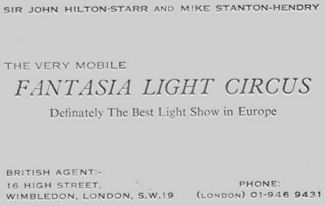
Nektar's original light show evolved rom the Fantasia Light Circus featuring Mick Brockett providing the rhythmic liquid / slide light shows with one
large white screen.
The Fantasia Light Circus supplemented the performances of Pink Floyd, Fleetwood Mac, Pretty Things etc. at the "Flight to the Lowlands Paradise"
in Holland in 1968.
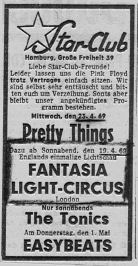
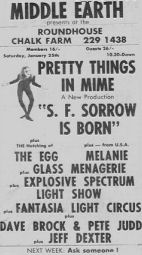 Following their short residence at Middle Earth (The Roundhouse) with such bands as Pink Floyd, Pretty Things and others, Fantasia / Mick Brockett arrived
in Germany in 1969, as an independent light show, providing the backdrop at Festivals and in clubs throughout Holland, Germany and Denmark. During the
summer of 1969, Mick projected his liquid light show with Prophecy (Nektar without Roye) at a week long gig at the Camera Club, in Furth. Fantasia covered
the lights for the 3–day Essen Pop & Blues Festival in October, then later that month, Mo attended Mick's show at "Beat Club" in Langelsheim.
Just after Prophecy became Nektar in November, Mick had been playing in southern Germany, where his truck froze solid (right before Christmas), so he
headed home to London, leaving his equipment near Stuttgart. At the same time, Mo was looking to enhance the Nektar presence on stage, as Mo and Mick
had discussed the possibility of their permanent liaison earlier. Nektar was definitely looking for something unique to complete the bands psychedelic
image so Mick, an admirer of Nektar's sound, joined the group as "light–musician" on January 10th, 1970 in Hamburg.
Following their short residence at Middle Earth (The Roundhouse) with such bands as Pink Floyd, Pretty Things and others, Fantasia / Mick Brockett arrived
in Germany in 1969, as an independent light show, providing the backdrop at Festivals and in clubs throughout Holland, Germany and Denmark. During the
summer of 1969, Mick projected his liquid light show with Prophecy (Nektar without Roye) at a week long gig at the Camera Club, in Furth. Fantasia covered
the lights for the 3–day Essen Pop & Blues Festival in October, then later that month, Mo attended Mick's show at "Beat Club" in Langelsheim.
Just after Prophecy became Nektar in November, Mick had been playing in southern Germany, where his truck froze solid (right before Christmas), so he
headed home to London, leaving his equipment near Stuttgart. At the same time, Mo was looking to enhance the Nektar presence on stage, as Mo and Mick
had discussed the possibility of their permanent liaison earlier. Nektar was definitely looking for something unique to complete the bands psychedelic
image so Mick, an admirer of Nektar's sound, joined the group as "light–musician" on January 10th, 1970 in Hamburg.
Nektar's "light and sound theater" was born.
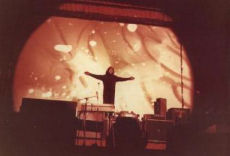
In 1970 Nektar's light show was mostly the original Fantasia light show. Mick kept on expanding the visual aspects of the show by adding more slides and
backdrop films which became the visual elements depicting Nektar's lyrics. Mick's good friend Keith Walters came over from London to assist Mick with
the slides for a year, when Keith left in mid–1972, Mick designed a foot switching system to control all the projections solo for a year, then gradually
expanded this concept with additional projectors until finally the one center screen didn't meet his needs and the stage and show had to be expanded.
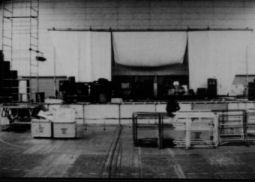
The New Nektar Light Theatre in 1974 incorporated three screens supported by sixty–four sections of scaffolds give a "Cinerama"
concept with an overall height of six meters. The stage was lit from "Fresnel" lights mounted above the screens and also from the sides. From
above the front of the stage came another 11,000 watts of colored light, which was hung from a reinforced truss that spanned the twelve meters between
the two forward scaffold towers. The floor was carpeted flat black, as was the five foot wall of stage amplification, then all lighting was tightly focused
to enhance individual band members whilst reducing glare on the projection screens. The musicians wore light colored clothing, thus this effect, as seen
from the audience, often made the band seem like 3D pop–ups within the panoramic projections.
The center screen still showed the original Nektar liquid light show, which overflowed into the sides, now
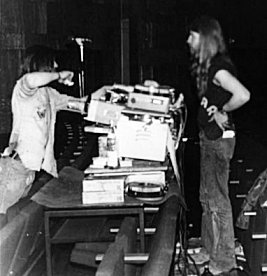 to overlaid with many new effects incurred by the use
of more carousel slide projectors (one of which floated and rotated, making the slides seem to fly). Two 16mm movie projectors showed special film effects,
strobe lights (one right above the drum kit) and a laser were also operated from the foot switches that enabled the center light show to be played in
tempo in real time with the band.
to overlaid with many new effects incurred by the use
of more carousel slide projectors (one of which floated and rotated, making the slides seem to fly). Two 16mm movie projectors showed special film effects,
strobe lights (one right above the drum kit) and a laser were also operated from the foot switches that enabled the center light show to be played in
tempo in real time with the band.
Mick's right–hand man Pete Lango was also responsible for operating a TYAS 20–channel dimmer board that controlled the stage lighting and made sure that
any extra equipment runs as smoothly as ever.

For this new light show Mick needed a minimum of two separate twenty amp feeds, plus a 60 amp power input just for the stage lighting. The concert halls
had to be at least six meters high above the stage to erect the four towers to their full extent. It was also in their contract that the hall must have
sufficient blackout, should the show happen to start before sunset! Above the PA system, which was also erected within the two towers in the front of
the stage, "Rabbie and Billy's department," was another source of extra light projections to fill the two adjacent side screens. In each tower
there were two projectors that created constantly moving colored pattern of lights and films working together to give the audience a more intense experience
of the light show than ever before.
To make this light show more interesting Mick used (besides his projectors, strobes and liquid lights) cuts of oil paintings that he suitably fitted to
visualize Nektar's lyrics and music. What ears heard, eyes saw: Mick played the tunes, which appeared on the huge screens, always steadily melting into
other colors. Strobe lights burst and stop short, while the infinity of color visions seemed to come back with even more power than before. Slides could
be seen coming and going as never having been there before, to surprise, in changed and new forms. This everlasting circulation of color vision ran in
perfect harmony to the music till the very end. The reason that the light show depicted the lyrics was because the lyrics were often created to fit slides
or movies (and liquids) whenever feasible, thus a spacey overall look became a huge part of the early shows.
Mick Brockett thinks the light show is an art form that was prematurely abandoned by the rock world, and although he's reluctant to talk about specifics
(he's had ideas lifted before), he soon begins to muse about lasers and how he'd like to have a flying saucer float from the screen and hover over the
audience.
 At times the light show was naturally the center of much attention with Mick constantly in motion manipulating the various and sundry gadgets necessary
to its production. He somehow manages to steal the show from the band quite often and to the delight of the generally well satisfied audience that has
been exposed to many of the pioneer light show efforts through the years by other bands.
At times the light show was naturally the center of much attention with Mick constantly in motion manipulating the various and sundry gadgets necessary
to its production. He somehow manages to steal the show from the band quite often and to the delight of the generally well satisfied audience that has
been exposed to many of the pioneer light show efforts through the years by other bands.